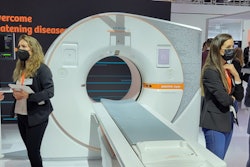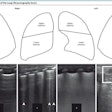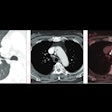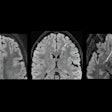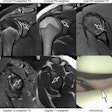
The 2022 Minnies awards showcase the growing momentum and clinical impact of photon-counting CT. The burgeoning technology featured in three different categories: Hottest Clinical Procedure, Best New Radiology Device, and Image of the Year.
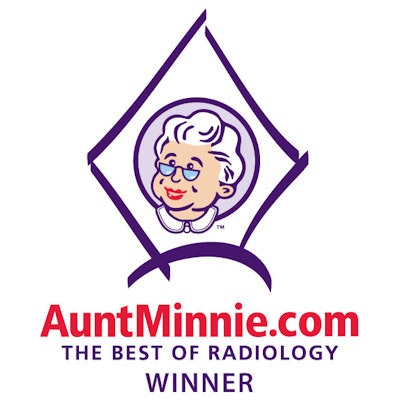
Not surprisingly, artificial intelligence (AI) is also an important theme for this year's awards. AI is the focus of the 2022 winners for Best New Radiology Vendor and Best New Radiology Software.
On the downside, burnout remains an issue that just won't go away, a damaging trend that has undoubtedly worsened due to the COVID-19 pandemic. For the fourth year in a row, physician burnout was voted the Biggest Threat to Radiology by the Minnies expert panel.
Congratulations to all the winners of the 2022 Minnies awards, and also to the runners-up and the more than 200 candidates who made the semifinalist list across 15 categories. You can also view our comprehensive list of all the Minnies winners over the past 23 years.
Most Influential Radiology Researcher
Minnies 2022 winner: Dr. Martin Pomper, PhD, Johns Hopkins University
Long known for his work in molecular imaging research, Dr. Martin Pomper, PhD, traces his beginnings in basic science to a job in 1982 working as a technician for chemical manufacturer Stepan Company in Northfield, IL.
One of the senior chemists perhaps recognized his potential, seemed utterly convinced he had to become a "professor," Pomper related.
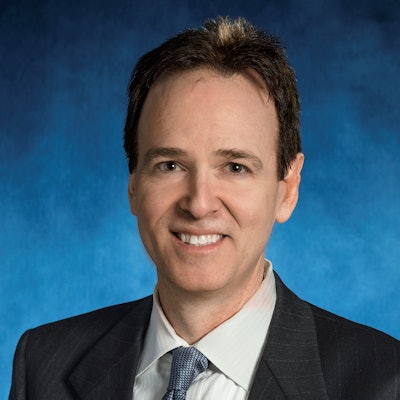 Dr. Martin Pomper, PhD.
Dr. Martin Pomper, PhD."He was so convinced, and I respected him so much, that I decided to focus on academic medicine after hearing his thoughts," he said. "For me, that meant application of basic science to medicine."
Pomper is now a professor of radiology and director of the division of nuclear medicine and molecular imaging at Johns Hopkins University, as well as associate dean for entrepreneurship and technology development. He has been on the radiology faculty at Johns Hopkins since 1995.
"What I'm passionate about is trying to address human illness and infirmity in whatever way I can," Pomper said. "And one way I do that is by leading a research group that applies basic science, in particular, chemistry toward developing new imaging agents."
Pomper helped develop F-18 DCFPyL, a PET radiotracer that targets prostate-specific membrane antigen (PSMA) in cases of prostate cancer. In May 2021, the U.S. Food and Drug Administration approved the radiotracer, which is sold commercially as Pylarify by Lantheus Medical Imaging.
The approval was the culmination of work that began for Pomper in 1996. That year, as a first-year assistant professor in neuroradiology, he came across an article in the Journal of Medicinal Chemistry by medicinal chemists at Zeneca Pharmaceuticals in Wilmington, DE. The article discussed the design and synthesis of a compound to inhibit neuropeptidase N-acetylated α-linked acidic dipeptidase (NAALADase), a brain enzyme.
The compound was presented as a potential therapeutic intervention in brain diseases in which altered levels of glutamate are thought to be involved. At the same time, Pomper noted an article in Proceedings of the National Academy of Sciences that showed NAALADase exhibited substantial sequence similarity to what was then an investigational human prostate cancer marker antigen -- PSMA.
"I then pivoted from developing brain imaging agents to prostate imaging and theranostic agents, the latter of which (prostate) are not fraught with a blood-brain barrier and therefore could more easily engage targets," he said.
Over the past year, Pomper has published and contributed to a number of follow-up papers on F-18 DCFPyL, such as a publication in Journal of Nuclear Medicine in August 2022 that offered guidance on selecting the most suitable candidates for F-18 DCFPyL PET/CT imaging.
"We're actually very fortunate that some of our imaging agents are helping to elevate the standard of care for detecting prostate cancer and are used around the world and are currently undergoing commercial production," he said.
Other papers Pomper has been involved with have discussed use of the agent in PET/CT to detect biochemical recurrence of prostate cancer after treatment, the best way to use the radiotracer to assess the success of therapy, and the best parameters to use when interpreting Pylarify images.
Pomper also conducted research into other radiopharmaceuticals, such as lutetium-177, which can also be used to target PSMA in prostate cancer cases. Further afield, he has also recently investigated near-infrared fluorescent imaging agents that target PSMA, as well as radiopharmaceuticals that target fibroblast activation protein alpha (FAP) in addition to PSMA.
After completing medical school and graduate school at the University of Illinois at Urbana-Champaign, Pomper arrived at Johns Hopkins as an intern at the Osler Medical Service. Following that, he completed residencies in diagnostic radiology and then in nuclear medicine. A fellowship in neuroradiology was followed by a 20-year run as a neuroradiology faculty member before he switched to nuclear medicine, which he now leads at Johns Hopkins.
In the coming years, keep an eye out for breakthroughs in precision medicine, artificial intelligence, theranostics, neuroinflammation, and immuno-oncology, he said.
"As healthcare delivery becomes more value-based, I'm hoping that we can integrate these precision imaging agents better into some of the work that's going on in the division, in the department of radiology, and in the medical school overall," Pomper said.
Runner-up: Maryellen Giger, PhD, University of Chicago
Most Effective Radiology Educator
Minnies 2022 winner: Dr. Christine Cooky Menias, Mayo Clinic, Phoenix, AZ
It was during her fourth year of residency at the George Washington University School of Medicine and Health Sciences in Washington, DC, that Dr. Christine Cooky Menias painfully learned what she describes as her "most important career lesson." Her father was diagnosed with pancreatic cancer, and as she accompanied him on his treatment journey she became "deeply aware that behind every image there is a real patient with a real story of sickness and hardship and that every patient and their family deserved the best care I could offer."
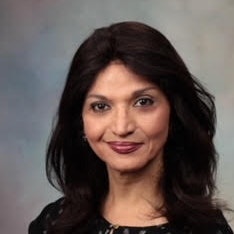 Dr. Christine Menias.
Dr. Christine Menias.This profound insight has shaped her career in diagnostic radiology and her work as a radiology educator, and it synchronized with the experience she had as a fourth-year medical student when she discovered radiology via an elective rotation. During the rotation, Menias met Dr. Riad Salem, currently chief of vascular and interventional radiology at Northwestern University in Chicago.
"Riad was the first to inspire me to become a diagnostic radiologist, even though he was headed to interventional," she said. "It reminds me that even the slightest acts of teaching and kindness can serve as role models and have a significant effect."
Menias has served as professor at the Mayo Clinic in Phoenix, AZ, for almost a decade and has taught at the Washington University School of Medicine in St. Louis for more than 20 years. In 2021, she was tapped as editor of Radiographics. (The position has brought part of her career full circle: Dr. Bill Olmsted of the University of Maryland in Baltimore -- the second editor of the journal -- was her attending at George Washington when she was a medical student.)
In her work, Menias takes the most satisfaction in using her skills and experience to help patients by supporting the rest of their care team and in teaching her students to stay curious when it comes to assessing patients.
"I deeply value keeping the patient central in my work and modeling this to my trainees," she said. "We can provide great patient care and grow in what we know as we collaborate with our emergency medicine, surgery, or internal medicine colleagues, bringing the clinical context to them via our reports and adding value to their patient care."
"My teaching file is gigantic, and I have both typical and atypical examples of just about everything," she said. "To share the spectrum of these cases we now publish 'Cases from the Cooky Jar' in Radiographics and on social media."
Being a radiology educator keeps Menias on her toes.
"Radiology is changing, and how to teach it is changing even faster," she said. "Digitization has brought instant access to information on many platforms with devices that fit in your hand. As radiology educators, our job is adapting our methods to all these exciting new possibilities."
Runner-up: Dr. Stefan Tigges, Emory University School of Medicine
Most Effective Radiologic Sciences Educator
Minnies 2022 winner: Kristi Moore, PhD, University of Mississippi Medical Center
It was a casual conversation with a friend that sparked Kristi Moore, PhD's career as a radiologic sciences educator. On the cusp of high school graduation, Moore was conducting an informal survey of sorts among her peers about what they planned to do in college -- and her friend's response intrigued her.
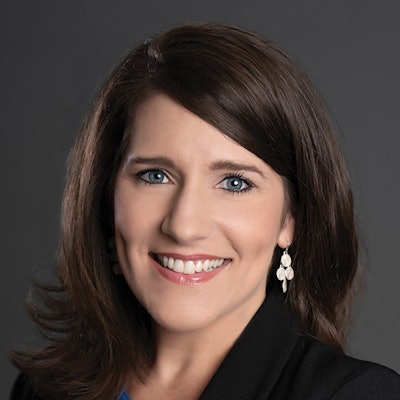 Kristi Moore, PhD.
Kristi Moore, PhD."I knew I wanted to pursue a career in the medical field, initially as a pediatrician or orthopedic surgeon," she said. "But the fear of the financial burden of medical school led me to explore other options. I asked a trusted friend what she was planning, and she had been accepted into the radiologic technology program at the University of Mississippi Medical Center (UMMC) in Jackson. It sounded interesting, so I decided to explore this career option."
The rest, as they say, is history. Moore was accepted into the same program and has remained dedicated to UMMC for over two decades. She worked initially as a diagnostic radiographer and then as a CT technologist before becoming a radiologic sciences educator. After matriculating with a bachelor's in health sciences, she went on to earn both a master's and a doctorate in clinical health sciences -- all from UMMC. Moore built her career as a radiologic sciences educator and is now chair and professor of the radiologic sciences department.
"My work challenges me to convey radiologic concepts in unique ways so that my students 'get it,' " she said. "Each person has different learning needs and styles, and I want to meet them where they are. It's thrilling when we're going over a difficult concept and I see the 'lightbulb go off' when a student comes to understanding."
Moore's "sweet spot" is advising students, she said.
"I enjoy discussing plans for the future with students and helping guide them to reach their goals. That's when I feel most in my element," she said. "As an educator, it is extremely rewarding to see your students succeed as their careers progress."
Moore is deeply committed to her own ongoing learning as well. She serves as board chair for the American Society of Radiologic Technologists (ASRT) and actively participates not only in that society's work but also in her state affiliate society, the Mississippi Society of Radiologic Technologists (MSRT).
Moore said she could not have achieved her professional goals had it not been for an incredible support system made up of her family, coworkers, community, and state and national professional societies.
"Teamwork makes the dream work," she said.
Runner-up: Louise Miller, Mammography Educators
Most Effective Radiology Administrator/Manager
Minnies 2022 winner: Gina Greenwood, University of Wisconsin Hospital, Madison
Radiology administration is a family affair for Gina Greenwood. When her older sister got interested in earning a degree in radiologic technology, Greenwood got interested, too. At just 17, she began a program in x-ray ("I couldn't even do fluoroscopy at the time, because I wasn't 18 yet," she said).
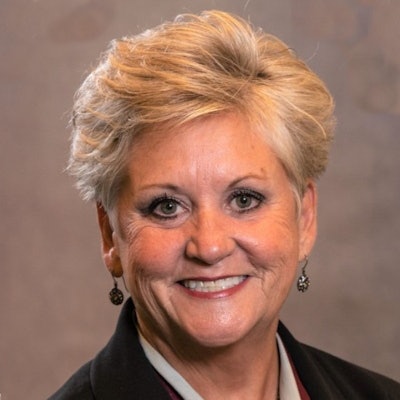 Gina Greenwood.
Gina Greenwood."My sister was pretty influential in my life, and I admired her," she said. "I decided to follow her path, and although she eventually left the field, I've continued. When I started, MRI was just coming on the scene, and working with it was something I knew I wanted to do."
After beginning her career as a staff technologist at the University of Iowa in Iowa City and then St. Luke's Hospital in Cedar Rapids, IA, Greenwood began the pursuit of furthering her education, ultimately earning an undergraduate degree in health arts and a master's degree in business administration. Eventually, Greenwood moved to specialize in MRI and then on to industry gigs with Lunar, GE Healthcare (then called GE Medical Systems), and IGC Medical Advances.
Through partnerships she made in industry, a colleague at the University of Wisconsin in Madison let Greenwood know that there was an opening for an MR manager in the radiology department, and she jumped at the opportunity. She's now senior director of radiology services.
"I'd been working in industry for about eight years and wanted to get reacquainted with the clinical space," she said.
One early project she worked on at University of Wisconsin was kitting out a room with an angiography system on one side and an MRI system on the other, with a specially outfitted radiographic fluoroscopy "garage door" between the rooms. The intent was to quickly transfer a patient from the angiography suite to the MRI to evaluate tissue perfusion after neuroendovascular interventions.
"We still have this setup, although we've converted it into a fully functional OR on one side which allows the opportunity for a wider set of clinical applications," she said. "The project was unique and unlike anything I'd done previously."
What gives Greenwood the most satisfaction in her career is the people with whom she works, she said.
"I'm so proud of the University of Wisconsin, and the people I work with here," she said. "Our department is internationally recognized for being on the leading edge, and it feels great to support and facilitate the research that makes that possible."
As for advice Greenwood would offer those interested in a career in radiology administration, she urges a long-term commitment to learning.
"Volunteer for everything you can, and be a lifelong learner," she said. "Put the effort in and you'll be rewarded back tenfold."
Runner up: Andrew Menard, JD, Johns Hopkins Health System, Baltimore







